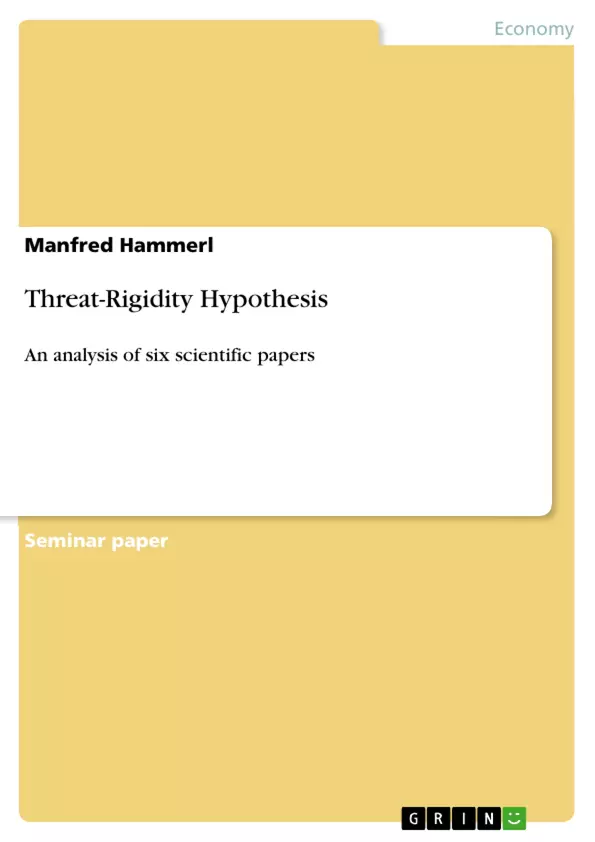For economists (and also sociologists or psychologists) – no matter if they are students,
practitioners or researchers – the behavior of individuals, groups or entire organizations (e. g.
companies) under special circumstances like threat, adversity or radical environmental change
is an important issue. For researchers to find underlying principles of behavior under threat
and for practitioners to learn some basic rules for behaving in changing environments.
Imagine a winter in our alps without any snow. There have always been times with less snow.
In such case snow making machines did their job and sprinkled the slope with artificial snow.
The lesser snow the more snow making machines was the easy calculus in past years. So will
there be an even larger number of snow making machines on the slopes if there is absolutely
no snow due to global warming and the upcoming climate crisis? Or will there some
alternatives be developed? According to an recent article in DerStandard (16. december 2006,
p. 2), wintertourism has to change its face, additional offers have to be presented, away form
ski and snowboard toward wellness, mountain biking or hiking. So what will entrepreneurs in
skiing resorts do? Will the rely on well-learned behavior and put another snow making
machine beside the slope, or will they consider alternatives?
There are numerous studies treating behavior under threat or radical change of environmental
conditions. Six papers – among them the basic paper for this work, Staw et al’s1 analysis of
threat-rigidity effects in organizational behavior – will subsequently be examined with regard
to consistencies or contradictions. As already mentioned, Staw et al’s paper will be regarded
as the basis for this seminar paper, as it points out most clearly threat-rigidity effects at
different levels of analysis. Moreover it is 1.) the oldest reviewed article and seems to have
some influence on threat-rigidity research in recent decades and 2.) represents a
comprehensive literature review in contrast to the other – mainly empirical – papers and
therefore presents a fine overview for our topic. Therefore chapter two will start with brief
discussions of the Threat-Rigidity Hypothesis and Threat-Rigidity Effects on the individualleve,
group-level and organizational-level as described in Staw et. al’s paper.
Table of Contents
- 1 Introduction
- 2 Threat-Rigidity Hypothesis
- 2.1 Individual-level effects
- 2.2 Group-level effects
- 2.3 Organizational-level effects
- 3 A multilevel point of view
- 3.1 Applying systems-theory
- 3.2 Cross-level effects
- 4 Conclusion and suggestions for future research
- 4.1 Two issues open to research emerged from my personal perception of this topic:
- References
Objectives and Key Themes
This seminar paper aims to analyze the Threat-Rigidity Hypothesis through the lens of six scientific papers, primarily focusing on the effects of threat and environmental change on individuals, groups, and organizations. The paper will delve into the theory's origins and explore its application across different levels of analysis, drawing on existing research to highlight consistencies and contradictions.
- Threat-Rigidity Hypothesis and its effects on different levels (individual, group, and organizational)
- Adaption to adversity and environmental change
- The influence of stress, anxiety, and arousal on individual behavior under threat
- The role of training and self-monitoring in mitigating threat-rigidity effects
- The impact of radical institutional change on organizational adaptation
Chapter Summaries
- Chapter 1: Introduction
This chapter introduces the concept of threat-rigidity effects in the context of organizational behavior. It highlights the importance of understanding how individuals, groups, and organizations respond to adversity and radical environmental change. The chapter introduces Staw et al.'s seminal work on the Threat-Rigidity Hypothesis and outlines the purpose and scope of the seminar paper.
- Chapter 2: Threat-Rigidity Hypothesis
This chapter delves into the theoretical foundations of the Threat-Rigidity Hypothesis, primarily drawing on Staw et al.'s work. It explores the concept of threat as a negative consequence of environmental change, and how entities, such as individuals and organizations, tend to rely on well-learned behavior under threat, which may not always be adaptive. The chapter also examines the effects of threat-rigidity at different levels, focusing on individual-level effects such as stress, anxiety, and arousal. It discusses how these factors can restrict information processing and constrict control mechanisms, leading to rigidity.
- Chapter 3: A Multilevel Point of View
This chapter examines the Threat-Rigidity Hypothesis from a multilevel perspective, applying systems theory to understand the interconnectedness of different levels of analysis. It explores the influence of individual-level behaviors on group and organizational dynamics. The chapter also analyzes cross-level effects, looking at how threat can impact different levels of analysis simultaneously.
Keywords
The seminar paper focuses on the Threat-Rigidity Hypothesis, analyzing the behavior of individuals, groups, and organizations under threat and environmental change. Key terms include threat, rigidity, adaption, stress, anxiety, arousal, information processing, control, training, self-monitoring, institutional change, organizational transformation, and multilevel analysis.
- Quote paper
- Bakk. Mag. Manfred Hammerl (Author), 2007, Threat-Rigidity Hypothesis, Munich, GRIN Verlag, https://www.grin.com/document/94346



